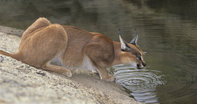
Name
Caracal (felis caracal) Order: Carnivora Family: FelidaeAppearance
The caracal is reddish light brown in colour, with faint spots of orange, a cream coloured underbelly and tufted black ears. All-black or Melanistic caracals have been reported.
With its long legs, it moves gracefully and is a skilled climber, regularly taking shelter in trees. Males measure about 117 cm in length with a mass of 15 kg, and females 109 cm weighing 11 kg.
The caracal with its striking face markings, is often considered to be one of the most beautiful cats in Africa.
Caracal Diet
The caracal is a strong and fast animal in relation to its size. It feeds on small prey such as jerboas, sand rats, ground squirrels and rock hyraxes, but also the larger reedbuck and duiker.
From sitting, it can launch itself four to five metres into the air, aided by its strong limbs and hindquarters to catch flying birds.
Being a nocturnal animal, it mainly hunts at night but also seeks prey in the twilight hours. Diurnal hunting for birds has been observed.
Caracal Breeding
After a gestation period of about 78 days, a litter of two to four, occasionally five, kittens are born. Birthing occurs during the months of October to March, and females frequently mate with up to three males.
Kittens gain about 21 g in weight daily, and are independent by 12 months of age even though maturity is only reached between 16 to 18 months.
 Cats use their ears to demonstrate their mood. Caracals’ ears, as well as the striking black and white facial markings, which are present ...
Cats use their ears to demonstrate their mood. Caracals’ ears, as well as the striking black and white facial markings, which are present ... Caracals have a reputation worldwide for their speed and agility in executing aerial bird kills....
Caracals have a reputation worldwide for their speed and agility in executing aerial bird kills.... Caracal prefer to hunt by night which affords them the best cover but a degree of kills do take place during the day on cool or cloudy days....
Caracal prefer to hunt by night which affords them the best cover but a degree of kills do take place during the day on cool or cloudy days....